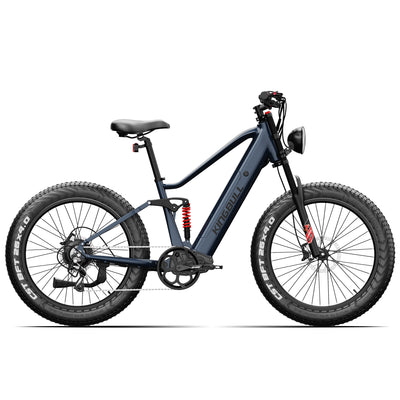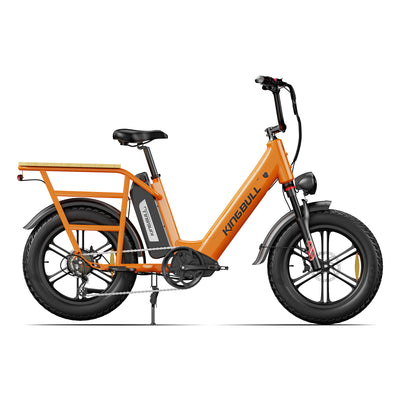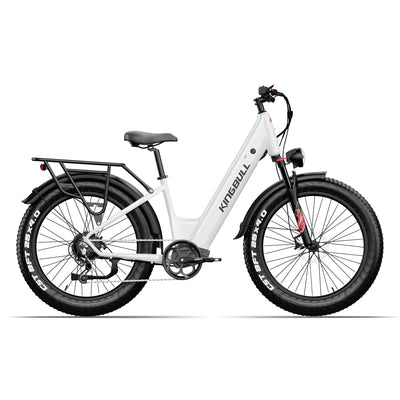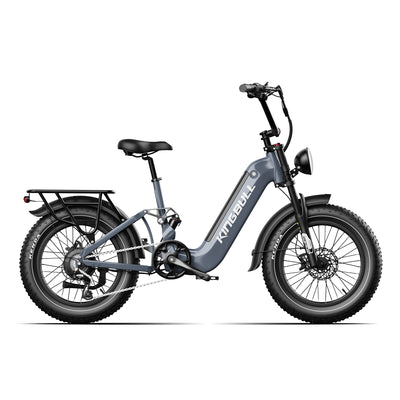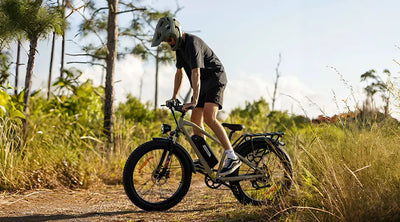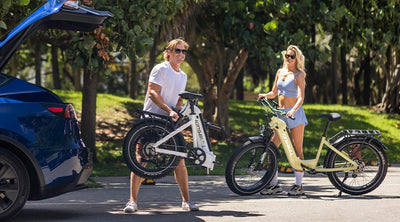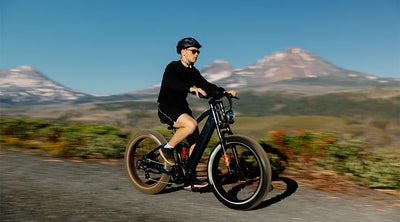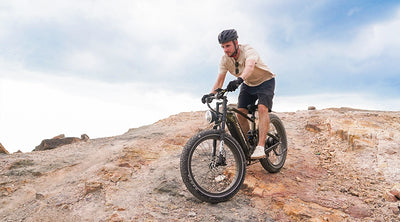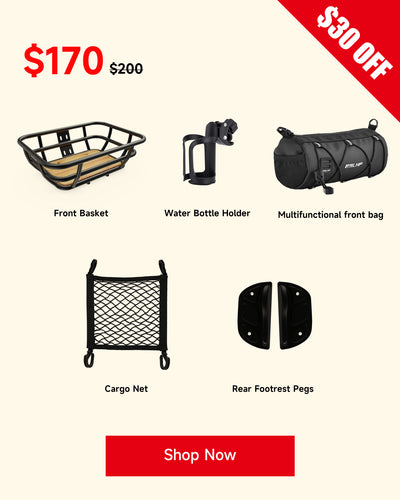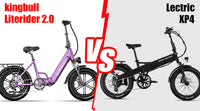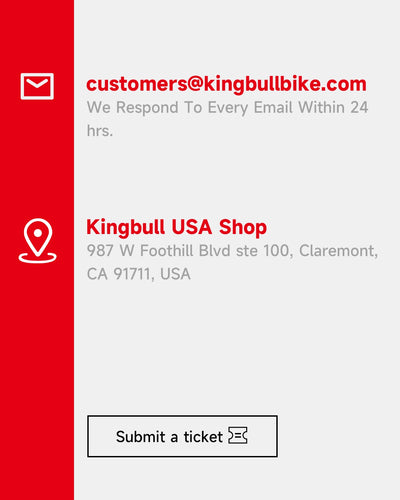Explore News
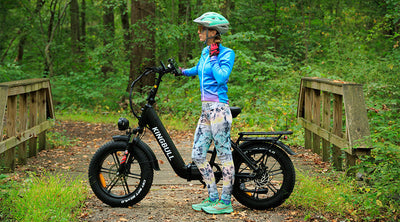
Tips & Cycling Knowledge
Ride into a New Season : Top E-Bike Routes for Spring Riding
As winter's chill fades and nature bursts into life, there's no better way to embrace spring than on an electric bike. E-bikes open up a world of possibilities, allowing riders of all fitness levels to conquer hills, cover greater distances, and truly immerse themselves in the season's beauty. Here are some fantastic spring e-bike routes to inspire your next adventure:
1. Coastal Bliss in California
Route: Santa Monica to Malibu (22 miles round trip)
Why it's great: Feel the ocean breeze as you cruise along the iconic Pacific Coast Highway. Stop at scenic overlooks, spot dolphins, and enjoy fresh seafood at Malibu's charming restaurants. The e-bike's assist makes tackling any inclines a breeze, leaving you free to soak in the stunning views.
2. Blooming Meadows in Washington
Route: Skagit Valley Tulip Fields (Various routes available)
Why it's great: Witness a breathtaking explosion of color as millions of tulips paint the landscape in vibrant hues. E-bikes allow you to effortlessly explore the vast fields, stopping to capture photos and revel in the floral spectacle.
3. Historic Charm in Virginia
Route: Virginia Creeper Trail (34 miles)
Why it's great: This scenic rail-trail winds through lush forests, charming towns, and historic trestle bridges. The gentle grade makes it perfect for a leisurely e-bike ride, allowing you to fully appreciate the area's natural beauty and rich history.
4. Urban Escape in New York City
Route: Central Park Loop (6.1 miles)
Why it's great: Experience the heart of NYC in a whole new way. Glide past iconic landmarks, serene lakes, and vibrant gardens, all while enjoying the convenience and ease of an e-bike. It's the perfect way to escape the city's hustle and bustle without leaving its limits.
5. Mountain Majesty in Montana
Route: Going-to-the-Sun Road, Glacier National Park (32 miles round trip)
Why it's great: Experience the awe-inspiring grandeur of Glacier National Park on this iconic route. While the full road may not be fully open in early spring, e-bikes allow you to access sections closed to cars, offering breathtaking views of snow-capped peaks, cascading waterfalls, and alpine meadows.
Tips for Spring E-Biking:
Layer up: Spring weather can be unpredictable, so dress in layers to adjust to changing temperatures.
Check trail conditions: Some routes may have closures or restrictions in early spring, so plan ahead.
Charge your battery: Cooler temperatures can affect battery life, so ensure your e-bike is fully charged before heading out.
Respect nature: Stay on designated trails, avoid disturbing wildlife, and pack out all trash.
Conclusion
Spring is a wonderful time point to embrace nature after a long period of staying at home with its combination of exercise, fresh air, and stunning scenery, it is a good chance to explore the world on an e-bike. So, grab your helmet, charge your battery, and get ready for an unforgettable adventure! During these weeks, there is Women's Day Sales for Kingbull bikes! Let's get some spring energy to get a new start of 2025!
Read more

Tips & Cycling Knowledge
How to Prevent Electric Bike Theft in the U.S.: A Practical Guide
Electric bikes are becoming increasingly popular in the U.S. due to their convenience and eco-friendliness. However, their high value also makes them a frequent target for theft. Losing a cherished e-bike can be a heartbreaking experience, especially when it’s a part of your daily routine or outdoor adventures.
The good news is that there are effective steps you can take to significantly reduce the risk of theft. Here’s a practical guide to help you protect your electric bike and enjoy your rides with peace of mind.
1. Choose the Right Locks
Invest in high-quality locks, such as U-locks, chain locks, or folding locks. For added security, use more than one type of lock to secure your bike. Thieves are less likely to carry multiple tools for breaking different types of locks, making your e-bike a tougher target.
2. Secure Your Bike Properly
Always lock your bike to a sturdy, immovable object, such as a metal railing or a ground-mounted bike rack.
Avoid securing your bike to weak or easily movable objects like small poles or thin fences.
Position the lock through the frame and one or both wheels to maximize security.
3. Park in Safe Locations
Indoors is Best: Whenever possible, store your e-bike indoors, such as in your home or garage.
Well-Lit Areas: If you must park outside, choose a well-lit, busy area, ideally with CCTV surveillance.
Avoid Secluded Spots: Don’t leave your e-bike in isolated or poorly monitored places, especially overnight.
4. Use GPS Trackers
Consider installing a GPS tracker on your e-bike. Many modern trackers are small, discreet, and can help you locate your bike if it’s ever stolen.
5. Register Your E-Bike
Register your e-bike with services like 529 Garage, which offers free platforms to store your bike’s information. Police and bike shops can use this registry to identify stolen bikes and return them to their rightful owners. Additionally, keep a record of your e-bike’s serial number and purchase details. For Kingbull bikes, you can find the serial number on the body.
6. Remove Accessories
Some parts of your electric bike, like the battery, display, or seat, can be easy targets for theft. To protect these valuable components, always remove the battery when parking, as it’s one of the most expensive parts of your e-bike. If your display is detachable, take it with you as well.
7. Stay Aware and Build a Theft-Prevention Mindset
Be Alert to Your Surroundings: Always pay attention to the area when parking your bike. If you notice anyone acting suspiciously, consider finding a different spot.
Switch Up Parking Locations: Avoid leaving your bike in the same place every day. Changing your routine can make it harder for thieves to target you.
Join a Community: Get involved in local biking groups or clubs to share theft-prevention tips, stay informed, and have a support network if your bike is ever stolen.
8. Use Alarm Systems
Installing an alarm on your e-bike can help deter potential thieves and draw attention to the situation if someone tries to lock or move the bike, these alarms emit a loud high pitched sound. It also provides additional security and reduces the risk of theft.
By following these tips, you can greatly reduce the risk of theft and keep your e-bike safe. Remember, a little preparation goes a long way in ensuring your peace of mind. Stay vigilant and enjoy the freedom and fun of riding your electric bike!
Read more

Tips & Cycling Knowledge
Exploring The Winter Landscape: Recommendations For The Best E-bike Rides
When the temperatures drop and snowflakes fill the air, it’s time to take your electric bike on a winter escapade. These carefully chosen cycling routes offer breathtaking scenery and a chance to experience the magic of winter from the saddle. Bundle up and explore some of the best trails in the U.S. this season!
1. Cherry Creek Trail - Colorado
This 40-mile trail begins in downtown Denver and winds its way through the suburbs, surrounded by serene forests and shimmering, snow-covered lakes. It’s a peaceful escape within an urban setting.
Why It’s Great: The paved paths ensure a smooth ride, making it suitable for cyclists of all skill levels.
What to Bring: Layered clothing and windproof gloves are a must to combat Colorado’s crisp winter air.
2. Slickrock Trail - Moab, Utah
Known for its iconic red sandstone formations, Slickrock Trail becomes a surreal landscape in winter, with dustings of snow creating dramatic contrasts.
Why It’s Great: This trail is a paradise for thrill-seekers who love challenging terrain and unparalleled views.
What to Bring: Equip your bike with fat tires for better traction and check trail conditions before heading out.
3. Pacific Coast Highway (Highway 1) - California
Stretching along the Pacific Ocean, this iconic highway offers stunning ocean views with dramatic waves and misty winter mornings.
Why It’s Great: Ideal for long-distance cyclists who enjoy breathtaking coastal scenery.
What to Bring: Choose a sunny day for your ride and wear layers to stay warm against the ocean breeze.
4. Carriage Roads - Acadia National Park, Maine
These gravel paths weave through the heart of Acadia National Park, surrounded by snow-blanketed trees and frozen lakes.
Why It’s Great: Perfect for families and leisure riders looking for tranquility and natural beauty.
What to Bring: Don’t forget a thermos with hot cocoa for a cozy break along the way.
5. Chain of Lakes - Minneapolis, Minnesota
This urban trail system loops around Minneapolis’ iconic lakes, offering panoramic views of winter landscapes.
Why It’s Great: A mix of city charm and natural beauty makes this a favorite among local cyclists.
What to Bring: Ride with caution as icy patches can appear on the trails.
Essential Winter Cycling Tips
To make the most of your winter rides, follow these tips:
Wear windproof and waterproof clothing to stay warm and dry.
Keep your speed in check, especially on slick paths.
Check weather forecasts and avoid riding during extreme conditions.
Map out your route and identify rest stops for breaks.
Conclusion
Winter cycling combines the thrill of adventure with the serenity of snow-covered landscapes. Whether you’re cruising along a coastal highway or tackling a rugged trail, these routes promise unforgettable experiences. With the right preparation and a sense of adventure, you can make this winter a season of discovery and joy. Grab your electric bike, embrace the chill, and explore the wonders of winter riding!
Read more
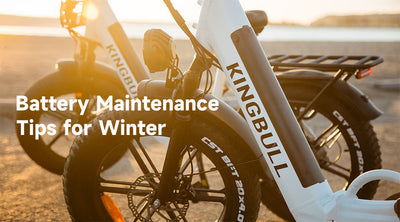
MaintenanceTips & Cycling Knowledge
Keep Your Electric Bike Powered Up This Winter: Battery Care Tips You Need
Winter can be tough on electric bike batteries, but with the right care, you can keep your bike running smoothly and extend the battery’s lifespan. Here’s a handy guide to help you navigate cold-weather battery maintenance so you can enjoy riding even in the chillier months.
1. How Cold Weather Affects Your Battery
Lithium-ion batteries are sensitive to temperature changes. In cold conditions, you may notice:
Reduced Range: Low temperatures temporarily lower battery capacity, which can shorten your ride distance.
Slower Charging: Charging efficiency drops in the cold, making the process take longer.
Risk of Over-Discharge: Repeated low-battery usage in cold weather can lead to faster battery degradation.
Understanding these effects is the first step to keeping your battery healthy during winter.
2. Tips for Battery Storage and Usage in Winter
Keep It Warm:
Store your battery indoors at room temperature (60°F - 77°F) when not in use.
Use an insulated battery cover to protect it if you’re riding in freezing conditions.
Charge After Each Ride:
Charge your battery promptly after riding, but let it warm up to room temperature before plugging it in if it’s been out in the cold.
Avoid Deep Discharge:
Keep the battery level above 30% during winter to prevent damage caused by over-discharge in cold weather.
3. Charging Your Battery in Cold Weather
Charge Indoors:
Always charge your battery in a warmer environment (above 50°F) to ensure proper charging performance.
Use the Right Charger:
Stick to the manufacturer’s recommended charger to avoid compatibility issues and maintain battery health.
Don’t Overcharge:
While modern batteries usually stop charging when full, unplug it after charging to prevent unnecessary stress on the battery.
4. Regular Cleaning and Inspections
Clean the Battery Contacts:Cold, wet conditions can lead to corrosion. Use a dry cloth or appropriate cleaner to wipe down the battery’s metal contacts regularly.
Inspect the Battery Casing:Check for cracks or damage to ensure moisture doesn’t seep in, which could harm the battery.
5. Maximizing Battery Range in Winter
Use Eco Mode:Riding in a lower power mode helps conserve battery life and extend your range.
Lighten the Load:Reducing the weight on your bike can help the battery work more efficiently.
Warm the Battery Before Riding:If the battery has been in a cold place, bring it indoors to warm up to room temperature before attaching it to the bike.
6. Storing Your Battery During the Off-Season
Charge It Just Right:For long-term storage, keep the battery at 40%-60% charge. Don’t store it fully charged or completely drained.
Store in the Right Place:Choose a dry, temperature-controlled spot (between 32°F and 95°F) to keep your battery safe.
7. Consider a Backup Battery
If you frequently ride in freezing temperatures or take long trips, having a fully charged spare battery can give you peace of mind.
Wrap-Up
Winter weather doesn’t have to slow you down. With proper battery care and maintenance, you can enjoy smooth, worry-free rides even in the coldest months. Taking a little extra time to protect your battery will help extend its life and ensure your bike performs its best all year round.
Ride smart, stay warm, and keep the adventures going this winter!
Read more

Kingbull NewsTips & Cycling Knowledge
Christmas Travel Guide: Make Your Holiday Sparkle with an Electric Bike
As the holiday season rolls in, many families are planning their Christmas getaways. Why not try something new this year? Bring an electric bike along for the ride! Whether you're heading out for a day trip or an extended holiday, an electric bike adds freedom, fun, and sustainability to your travel plans. Here’s how you can make your Christmas travels unforgettable with an e-bike.
1. Why Choose an Electric Bike for Holiday Travel?
Electric bikes are a game-changer for holiday adventures. Here’s why they’re the perfect travel companion:
Effortless Rides: Tackle hills and long distances with ease, thanks to pedal assist and powerful motors.
Eco-Friendly Fun: Cut down on your carbon footprint while exploring new places.
Portable and Convenient: Foldable e-bikes fit easily into car trunks or RVs, making them ideal for road trips.
Versatile for Everyone: Whether you’re riding solo or with family, there’s an e-bike for every need.
2. Top Holiday Destinations for Electric Bike Adventures
Looking for the perfect place to ride this Christmas? Check out these festive spots:
Holiday Light Tours: Explore neighborhoods decked out in dazzling Christmas lights. Cities like New York’s Dyker Heights or Los Angeles’ Griffith Park are must-sees. Glide through the magic without worrying about traffic or parking.
Winter Beach Escapes: Ride along sunny coastlines in Florida’s South Beach or California’s Santa Monica Pier. Even in winter, these spots offer warm, scenic rides.
Snowy Adventures: For those craving a winter wonderland, Colorado and Utah offer breathtaking snowy trails perfect for e-bike exploration.
3. How to Use Electric Bikes During Your Trip
Electric bikes bring unmatched flexibility to your holiday plans. Here’s how you can make the most of them:
City Sightseeing: Skip the traffic and explore bustling holiday markets, local shops, and festive landmarks with ease.
Nature Getaways: Discover hidden gems in national parks or countryside trails where cars can’t go.
Family Fun: Cargo e-bikes make it easy to bring along kids, pets, or even a pile of holiday gifts.
4. Winter Riding Tips for the Holiday Season
Riding during the winter holidays can be magical, but preparation is key:
Keep Your Battery Warm: Cold weather can affect battery performance. Store your battery indoors when not in use and consider using a thermal cover.
Bundle Up: Wear windproof gloves, a warm jacket, and a winter cycling helmet to stay cozy.
Be Seen: Equip your e-bike with bright lights and reflective gear to ensure visibility during shorter winter days.
Use Winter Tires: If you’re riding in icy or snowy conditions, fat tires or studded options provide extra grip.
5. Special Holiday Offers: Make Your Christmas Brighter
Ready to take your holiday travels to the next level? We’ve got festive deals to help you get started:
$250 Off Two Bikes: Perfect for couples or families who want to ride together.
$30 Off Accessories Over $150: Use code GYE452 to snag the perfect holiday add-ons.
Shipping to Hawaii: Celebrate Christmas island-style with convenient delivery options.
6. Embrace the Magic of Christmas with an Electric Bike
This holiday season, take a break from the usual and embrace the freedom of an electric bike. Whether you’re riding under twinkling lights, cruising along the coast, or exploring snowy trails, an e-bike will elevate your travel experience.
So, what are you waiting for? Start planning your Christmas e-bike adventure today and make this holiday one to remember.
Happy Holidays and Happy Riding! 🎄🚴♂️
Read more

Tips & Cycling Knowledge
Chilly Rides: Why Your E-Bike Might Feel Sluggish in Winter
In winter, many riders notice their electric bikes don’t feel as fast or powerful as they do in warmer months. This change is influenced by factors like battery performance, motor efficiency, tire behavior, and riding conditions. Understanding these reasons can help you maintain your bike better and enjoy a safer, more comfortable ride during the colder season.
1. Battery Performance in Cold Weather
The battery is the heart of your electric bike, and it’s sensitive to temperature changes. Here’s what happens when the mercury drops:
Chemical Reaction Slowdown: Lithium-ion batteries operate best between 68°F and 77°F (20°C to 25°C). In colder weather, the chemical reactions inside the battery slow down, reducing energy output and making the ebike feel less powerful.
Increased Internal Resistance: Cold temperatures increase the battery's internal resistance, causing a greater voltage drop. This results in less power being delivered to the motor, further reducing speed.
2. Motor Efficiency in the Cold
The motor also struggles in winter conditions:
Demagnetization: If your motor has experienced wear and tear, low temperatures can worsen demagnetization, reducing its power output.
Thickened Lubricants: The lubricating oil inside the motor thickens in cold weather, increasing friction and decreasing efficiency, which slows down the ebike.
3. Tire Challenges
Winter impacts your ebike’s tires in several ways:
Lower Tire Pressure: Cold air contracts, reducing tire pressure. Lower pressure increases rolling resistance, making pedaling harder and slowing the bike.
Slippery Roads: Snow, ice, and stiff tires reduce grip, forcing us to ride cautiously.
4. Rider Adjustments
We, the riders, also adapt our behavior in winter, which affects speed:
Bundled Up: Thick winter clothing limits movement, making it harder to ride efficiently.
Safety First: Slippery roads and poor visibility encourage slower speeds to avoid accidents.
5. Controller’s Protection Mechanism
Your bike’s controller has a low-voltage protection setting to safeguard the battery. In winter, the battery drains faster due to reduced performance, hitting this threshold sooner. When that happens, the controller limits power output, further slowing down your ebike.
Embracing Winter Riding
While it can be frustrating that your electric bike isn’t as zippy in winter, these slower rides can still be enjoyable. Take the opportunity to:
Admire the winter scenery.
Adjust your riding style for safety.
Take care of your battery by keeping it warm before riding.
Understanding why your ebike behaves differently in the cold helps you adapt and make the most of your winter rides. So, bundle up, ride safe, and share your winter cycling adventures with fellow riders. Happy pedaling!
Read more




